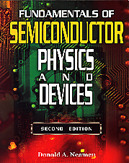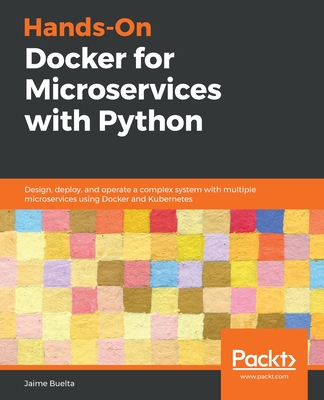Solid State Electronic Devices, 7/e (GE-Paperback)
暫譯: 固態電子元件,第7版 (GE-平裝本)
Ben Streetman , Sanjay Banerjee
- 出版商: Pearson FT Press
- 出版日期: 2016-01-01
- 售價: $1,410
- 貴賓價: 9.8 折 $1,382
- 語言: 英文
- 頁數: 632
- ISBN: 1292060557
- ISBN-13: 9781292060552
-
相關分類:
電子學 Eletronics
-
相關翻譯:
半導體元件, 7/e (Streetman: Solid State Electronic Devices, 7/e) (繁中版)
立即出貨 (庫存 < 3)
買這商品的人也買了...
-
 高頻交換式電源供應器原理與設計, 2/e
高頻交換式電源供應器原理與設計, 2/e$390$351 -
 固態物理學導論 (Kittel :Introduction to Solid State Physics, 8/e)
固態物理學導論 (Kittel :Introduction to Solid State Physics, 8/e)$780$764 -
 Semiconductor Physics and Devices: Basic Principles, 4/e (IE-Paperback)
Semiconductor Physics and Devices: Basic Principles, 4/e (IE-Paperback)$1,230$1,058 -
 Optoelectronics and Photonics: Principles and Practices, 2/e (IE-Paperback)
Optoelectronics and Photonics: Principles and Practices, 2/e (IE-Paperback)$1,290$1,264 -
 半導體元件物理與製作技術, 3/e (Semiconductor Devices Physics and Technology, 3/e)
半導體元件物理與製作技術, 3/e (Semiconductor Devices Physics and Technology, 3/e)$900$855 -
 Pulse-Width Modulated DC-DC Power Converters, 2/e (Hardcover)
Pulse-Width Modulated DC-DC Power Converters, 2/e (Hardcover)$1,890$1,852 -
 Microelectronic Circuits, 7/e (Paperback)
Microelectronic Circuits, 7/e (Paperback)$1,620$1,588 -
半導體元件, 7/e (Streetman: Solid State Electronic Devices, 7/e)
$720$706 -
 Digital Systems Design Using VHDL, 3/e (IE-Paperback)
Digital Systems Design Using VHDL, 3/e (IE-Paperback)$1,120$1,098 -
 Advanced Engineering Mathematics, 8/e (SI Edition)(Paperback)
Advanced Engineering Mathematics, 8/e (SI Edition)(Paperback)$1,420$1,392 -
 Fundamentals of Semiconductor Devices, 2/e (IE-Paperback)
Fundamentals of Semiconductor Devices, 2/e (IE-Paperback)$1,250$1,225 -
 微電子學題解 (下), 7/e (Smith: Microelectronic Circuits, 7/e)
微電子學題解 (下), 7/e (Smith: Microelectronic Circuits, 7/e)$580$568 -
 Gallium Nitride and Silicon Carbide Power Devices (Hardcover)
Gallium Nitride and Silicon Carbide Power Devices (Hardcover)$1,980$1,940 -
 向量演算學及其應用 (Vector Calculus with its Applications)
向量演算學及其應用 (Vector Calculus with its Applications)$420$412 -
 Digital Design: With an Introduction to the Verilog HDL, VHDL, and SystemVerilog, 6/e (GE-Paperback)
Digital Design: With an Introduction to the Verilog HDL, VHDL, and SystemVerilog, 6/e (GE-Paperback)$1,380$1,352 -
 Kittel`s Introduction to Solid State Physics (Global Edition)(Paperback)
Kittel`s Introduction to Solid State Physics (Global Edition)(Paperback)$1,580$1,548 -
 Concepts of Modern Physics (IE-Paperback)
Concepts of Modern Physics (IE-Paperback)$1,180$1,156 -
 Fundamentals of Electric Circuits, 7/e (IE-Paperback)
Fundamentals of Electric Circuits, 7/e (IE-Paperback)$1,350$1,323 -
 Fundamentals of Power Electronics, 3/e (Hardcover)
Fundamentals of Power Electronics, 3/e (Hardcover)$2,700$2,646 -
 Microelectronic Circuits, 8/e (Paperback)
Microelectronic Circuits, 8/e (Paperback)$4,380$4,292 -
 Advanced Engineering Mathematics, 7/e (Paperback)
Advanced Engineering Mathematics, 7/e (Paperback)$1,420$1,392 -
 Average Current-Mode Control of DC-DC Power Converters (Hardcover)
Average Current-Mode Control of DC-DC Power Converters (Hardcover)$1,850$1,813 -
 Power Magnetic Devices: A Multi-Objective Design Approach (Hardcover)
Power Magnetic Devices: A Multi-Objective Design Approach (Hardcover)$1,980$1,940 -
 Solid State Physics (Paperback)
Solid State Physics (Paperback)$1,980$1,940 -
 微電子學 (下冊), 8/e (Smith: Microelectronic Circuits, 8/e)
微電子學 (下冊), 8/e (Smith: Microelectronic Circuits, 8/e)$880$862
商品描述
- For undergraduate electrical engineering students or for practicing engineers and scientists interested in updating their understanding of modern electronics
One of the most widely used introductory books on semiconductor materials, physics, devices and technology, Solid State Electronic Devices aims to: 1) develop basic semiconductor physics concepts, so students can better understand current and future devices; and 2) provide a sound understanding of current semiconductor devices and technology, so that their applications to electronic and optoelectronic circuits and systems can be appreciated. Students are brought to a level of understanding that will enable them to read much of the current literature on new devices and applications.
Teaching and Learning Experience
This program will provide a better teaching and learning experience–for you and your students. It will help:- Provide a Sound Understanding of Current Semiconductor Devices: With this background, students will be able to see how their applications to electronic and optoelectronic circuits and systems are meaningful.
- Incorporate the Basics of Semiconductor Materials and Conduction Processes in Solids: Most of the commonly used semiconductor terms and concepts are introduced and related to a broad range of devices.
- Develop Basic Semiconductor Physics Concepts: With this background, students will be better able to understand current and future devices.
- Provide a Sound Understanding of Current Semiconductor Devices
The authors have chosen devices to discuss that are broadly illustrative of important principles at the undergraduate level.- The basics of semiconductor materials and conduction processes in solids are incorporated to understand p-n junctions, bipolar and metal oxide semiconductor transistors, optoelectronic and other devices.
- A discussion of device fabrication processes and CMOS integrated circuit technology, along with data in the Appendices, provide a useful understanding of how semiconductor devices are made.
- The extensive discussion of circuit and other application examples provides students with feedback about the practical relevance of the theory.
- UPDATED: The discussion of MOS devices is updated, both in the underlying theory of ballistic FETs as well as discussion of advanced MOSFETs such as FinFETs, strained Si devices, metal gate/ high-k devices, III-V high channel mobility devices.
- UPDATED: The treatment of optoelectronic devices is updated, including high bandgap nitride semiconductors and quantum cascade lasers
- NEW: A brand new section on nanoelectronics introduces students to exciting concepts such as 2D materials including graphene and topological insulators, 1D nanowires and nanotubes, and 0D quantum dots.
- NEW: A new discussion highlights spintronics and novel resistive and phase change memories.
All of the devices covered are important in today’s electronics; furthermore, learning about these devices should be an enjoyable and rewarding experience.- The first four chapters of the book provide background on the nature of semiconductors and conduction processes in solids.
- Included is a brief introduction to quantum concepts (Chapter 2) for those students who do not already have this background from other courses.
- Chapter 5 describes the p-n junction and some of its applications.
- Chapters 6 and 7 deal with the principles of transistor operation.
- Chapter 8 covers optoelectronics and Chapter 9 discusses integrated circuits.
- Chapter 10 applies the theory of junctions and conduction processes to microwave and power devices.
- NEW: This edition features about 100 new problems and updated references that extend concepts in the text.
- Reading Lists: As a further aid in developing techniques for independent study, the reading list at the end of each chapter includes a few articles which students can read as they study this book. Some exposure to periodicals is useful in laying the foundation for a career of constant updating and self-education. A summary of the key concepts is included at the end of each chapter.
- Problems: One of the keys to success in understanding this material is to work problems that exercise the concepts. The problems at the end of each chapter are designed to facilitate learning the material. Very few are simple “plug-in” problems. Instead, they are chosen to reinforce or extend the material presented in the chapter. In addition, “self quiz” problems test students’ conceptual understanding.
- Key Equations: A listing of the key equations for semiconductor devices on the inside covers of the book is arranged thematically to help students digest the concepts.
- Units: Examples and problems are stated in terms of units commonly used in the semiconductor literature. The basic system of units is rationalized MKS, although cm is often used as a convenient unit of length. Similarly, electron volts (eV) are often used rather than joules (J) to measure the energy of electrons. Units for various quantities are given in Appendices I and II.
New to this edition
Provide a Sound Understanding of Current Semiconductor Devices
The authors have chosen devices to discuss that are broadly illustrative of important principles at the undergraduate level.- The discussion of MOS devices is updated, both in the underlying theory of ballistic FETs as well as discussion of advanced MOSFETs such as FinFETs, strained Si devices, metal gate/ high-k devices, III-V high channel mobility devices.
- The treatment of optoelectronic devices is updated, including high bandgap nitride semiconductors and quantum cascade lasers
- A brand new section on nanoelectronics introduces students to exciting concepts such as 2D materials including graphene and topological insulators, 1D nanowires and nanotubes, and 0D quantum dots.
- A new discussion highlights spintronics and novel resistive and phase change memories.
- This edition features about 100 new problems and updated references that extend concepts in the text.
商品描述(中文翻譯)
- 適合本科電機工程學生或對更新現代電子學理解感興趣的在職工程師和科學家
《固態電子元件》是一本廣泛使用的半導體材料、物理、元件和技術的入門書籍,旨在:1) 發展基本的半導體物理概念,以便學生能更好地理解當前和未來的元件;2) 提供對當前半導體元件和技術的扎實理解,以便能夠欣賞其在電子和光電子電路及系統中的應用。學生將達到一個理解的水平,使他們能夠閱讀當前有關新元件和應用的文獻。
教學與學習體驗
本計劃將提供更好的教學與學習體驗——對您和您的學生都有幫助。它將幫助:
-
提供對當前半導體元件的扎實理解:有了這個背景,學生將能夠看到它們在電子和光電子電路及系統中的應用是有意義的。 -
融入半導體材料和固體導電過程的基本知識:大多數常用的半導體術語和概念都被介紹並與廣泛的元件相關聯。 -
發展基本的半導體物理概念:有了這個背景,學生將能更好地理解當前和未來的元件。 -
提供對當前半導體元件的扎實理解
作者選擇了廣泛說明本科層級重要原則的元件進行討論。
- 融入半導體材料和固體導電過程的基本知識,以理解 p-n 接面、雙極性和金屬氧化物半導體晶體管、光電子及其他元件。
- 對元件製造過程和 CMOS 集成電路技術的討論,以及附錄中的數據,提供了對半導體元件製造過程的有用理解。
- 對電路及其他應用示例的廣泛討論,為學生提供了有關理論實際相關性的反饋。
-
更新:對 MOS 元件的討論已更新,包括彈道 FET 的基本理論以及對先進 MOSFET(如 FinFET、應變 Si 元件、金屬閘/高介電常數元件、III-V 高通道移動性元件)的討論。 -
更新:對光電子元件的處理已更新,包括高帶隙氮化物半導體和量子級聯激光器。 -
新:全新部分介紹納米電子學,讓學生接觸到令人興奮的概念,如包括石墨烯和拓撲絕緣體的 2D 材料、1D 奈米線和奈米管,以及 0D 量子點。 -
新:新的討論突顯自旋電子學和新型電阻式及相變記憶體。
融入半導體材料和固體導電過程的基本知識
所有涵蓋的元件在當今電子學中都很重要;此外,學習這些元件應該是一個愉快且有益的體驗。
- 本書的前四章提供了半導體的性質和固體導電過程的背景。
- 包括對量子概念的簡要介紹(第 2 章),以便那些未從其他課程獲得此背景的學生使用。
- 第 5 章描述了 p-n 接面及其一些應用。
- 第 6 章和第 7 章處理晶體管操作的原理。
- 第 8 章涵蓋光電子學,第 9 章討論集成電路。
- 第 10 章將接面和導電過程的理論應用於微波和功率元件。
發展基本的半導體物理概念-
新:本版包含約 100 道新問題和更新的參考資料,擴展了文本中的概念。 -
閱讀清單:作為進一步幫助發展獨立學習技巧的輔助,書末每章的閱讀清單包括幾篇學生在學習本書時可以閱讀的文章。接觸期刊對於奠定持續更新和自我教育的職業基礎是有用的。每章末尾包含關鍵概念的摘要。 -
問題:理解這些材料成功的關鍵之一是解決能夠運用概念的問題。每章末尾的問題旨在促進對材料的學習。很少有簡單的“代入”問題。相反,它們的選擇旨在加強或擴展章節中呈現的材料。此外,“自我測驗”問題測試學生的概念理解。 -
關鍵方程式:書內封面列出了半導體元件的關鍵方程式,按主題排列,以幫助學生消化概念。 -
單位:示例和問題以半導體文獻中常用的單位表述。基本的單位系統是合理化的 MKS,儘管 cm 常用作方便的長度單位。同樣,電子伏特(eV)常用來測量電子的能量,而不是焦耳(J)。各種量的單位在附錄 I 和 II 中給出。
本版的新內容
提供對當前半導體元件的扎實理解
作者選擇了廣泛說明本科層級重要原則的元件進行討論。
- 對 MOS 元件的討論已更新,包括彈道 FET 的基本理論以及對先進 MOSFET(如 FinFET、應變 Si 元件、金屬閘/高介電常數元件、III-V 高通道移動性元件)的討論。
- 對光電子元件的處理已更新,包括高帶隙氮化物半導體和量子級聯激光器。
- 全新部分介紹納米電子學,讓學生接觸到令人興奮的概念,如包括石墨烯和拓撲絕緣體的 2D 材料、1D 奈米線和奈米管,以及 0D 量子點。
- 新的討論突顯自旋電子學和新型電阻式及相變記憶體。
發展基本的半導體物理概念- 本版包含約 100 道新問題和更新的參考資料,擴展了文本中的概念。
-
作者簡介
Ben Streetman, University of Texas, Austin
Sanjay Banerjee, University of Texas, Austin
作者簡介(中文翻譯)
本·斯特里特曼(Ben Streetman),德克薩斯大學奧斯汀分校
桑傑·巴納吉(Sanjay Banerjee),德克薩斯大學奧斯汀分校
目錄大綱
1. Crystal Properties and Growth of Semiconductors
2. Atoms and Electrons
3. Energy Bands and Charge Carriers in Semiconductors
4. Excess Carriers in Semiconductors
5. Junctions
6. Field-Effect Transistors
7. Bipolar Junction Transistors
8. Optoelectronic Devices
9. Integrated Circuits
10. High-Frequency, High-Power and Nanoelectronic Devices
Appendices
I. Definitions of Commonly Used Symbols
II. Physical Constants and Conversion Factors
III. Properties of Semiconductor Materials
IV. Derivation of the Density of States in the Conduction Band
V. Derivation of Fermi-Dirac Statistics
VI. Dry and Wet Thermal Oxide Thickness Grown on Si (100) as a function of Time and Temperature
VII. Solid Solubilities of Impurities in Si
VIII. Diffusivities of Dopants in Si and SiO2
IX. Projected Range and Straggle as Function of Implant Energy in Si
目錄大綱(中文翻譯)
1. Crystal Properties and Growth of Semiconductors
2. Atoms and Electrons
3. Energy Bands and Charge Carriers in Semiconductors
4. Excess Carriers in Semiconductors
5. Junctions
6. Field-Effect Transistors
7. Bipolar Junction Transistors
8. Optoelectronic Devices
9. Integrated Circuits
10. High-Frequency, High-Power and Nanoelectronic Devices
Appendices
I. Definitions of Commonly Used Symbols
II. Physical Constants and Conversion Factors
III. Properties of Semiconductor Materials
IV. Derivation of the Density of States in the Conduction Band
V. Derivation of Fermi-Dirac Statistics
VI. Dry and Wet Thermal Oxide Thickness Grown on Si (100) as a function of Time and Temperature
VII. Solid Solubilities of Impurities in Si
VIII. Diffusivities of Dopants in Si and SiO2
IX. Projected Range and Straggle as Function of Implant Energy in Si































